Hockey drills
- There are 2 passers on the PC points on the back line to the right and left of the goal.
- The player starts behind the 25 yard line, receives the ball from the left, gets the ball to the semi-circle and then has to score.
- This player then sprints past the penalty mark, then sprints back behind the 25 yard line, and then has to run back towards the goal to receive the pass from the other attacker (right) and do the same (scoring, sprint past the strokepunt/puntball point and back to the 25 yard line)
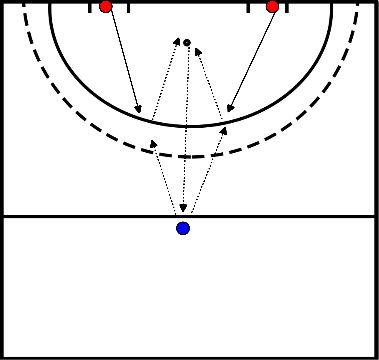
- Use pilons to set up two squares
- Around the dotted head circle (left and right next to/opposite the goal)
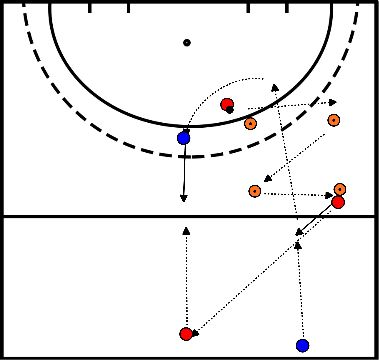
- Keeper on target
- Place 2 gates of pilons on the 23-metre line (the gates are on the left and right side of the goalposts)
- Player red starts on the head circle and accelerates with ball through the gates.
- Immediately after passing the gates, red passes to blue.
- Red sprints around a pilon to put pressure and/or take the ball away from blue.
- After receiving the ball, blue accelerates with ball and runs through the gates.
- If blue passes through the gates, red is not allowed to take the ball and has to go back to the pilon.
- Blue accelerates into the head circle and shoots at the goal.

- Make a triangle with pilons (2 meters between each pilon).
- Player red starts with ball at the pilon 5 meters away from the triangle.
- Player red passes to player blue while he dynamically moves towards and around the triangle.
- Player blue pivots the ball and plays the ball to player white.
- Player white plays the ball back to the starting point (red).
- During the exercise, each player runs behind his/her ball.
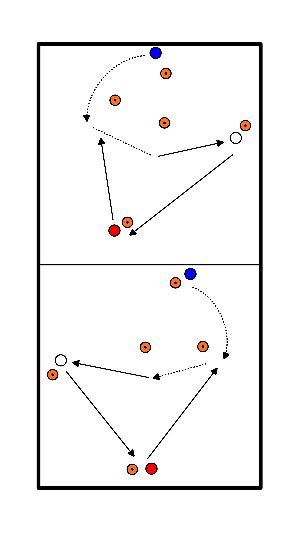
- The game starts with a pass from player 1 to player 2
- Player two gives a clean pass along the line
- Whereupon player 3 runs towards the line to receive the ball with a backhand
- Player 4 runs along the pilon and positions himself on the top of the circle or continues running by the tip.
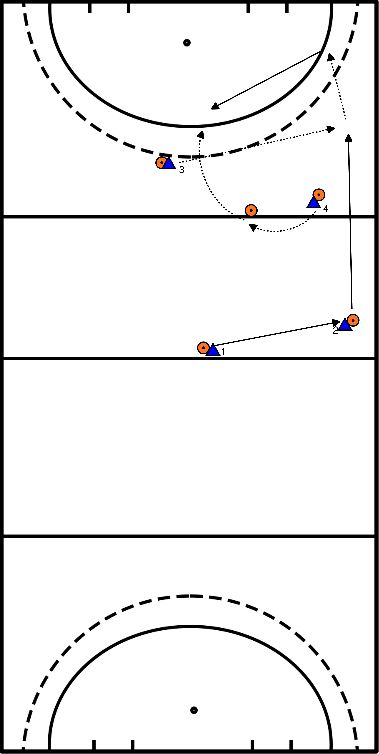
Place 15 to 20 pylons over a distance of about 40 metres from the rear line towards the middle line, in a straight line. The spacing between them at the basic form is 2 meters.
Make 2 rows that are positioned behind the back line. The players do their exercise on both sides of the pylons at the same time towards the end of the series of pylons. There they turn and dribble with a wide curve back to the beginning. When the first two are at the fourth pylon, the next two can start.
Put players with an equal physical capacity next to each other. You can do a positional approach (defender versus defender, attacker versus attacker).
Exercise
1. On the signal the front 2 players start.
2. Sprint each time 2 pylons forward and then 1 pylon backward.
3. Keep your face forward, so don't turn during the exercise.
4. The intensity is 90% of the maximum capacity. Especially the forward runs (starting away) must be explosive and with short steps.
5. At the end of the series of pylons you turn with a wide bend and dribble easily back to the starting point.
6. Repeat this exercise once.
Variations
1. Identical to the basic form, but now with the pylons in a different pattern: between the first 2 pylons is 1 meter, between the next 2 meters, then 3 meters, 4 meters and finally 5 meters. After this you go down again (respectively 4, 3, 2 and 1 meter space between the pylons). In total you will have 18 pylons.
2. Identical to the basic form, but now with a different pattern: between the first 3 pylons 1 meter, the next 2 pylons 5 meter, then again 3 pylons with 1 meter, 2 pylons with 5 meter. After this, place the same pattern again (4 times the same pattern in 1 line, with a total of 18 pylons).
3. Identical to variation 3, but now you don't place the pylons in a straight line, but in curves.
4. You make a straight line of pylons and arrange them as you see fit. Make sure there is a lot of variation.
5. Identical to variation 4, but now with faint curves.
Intensity of the exercise
The intensity is 90% of the maximum effort. Panting, should be motivated execution with highly explosive character in the runs with a maintained body control and athletic posture, EMI 7/8.
The player with the red pilon is ready for the long corner. This player plays the ball to the left and gives the ball to the player coming from the white pilon. The player of the white pilon plays the ball as hard as possible into the circle (towards the goal).
When the long corner is taken, the players try to run into the blue and orange pilon and intercept the ball. The player who intercepts the ball scores on the back line and the other player scores on the 23-m line. It becomes a 1 to 1.
Swap: Red - White - Blue - Orange - Red
Attention: The player who takes the long corner stands ready as if he himself is going towards the circle. Pass the ball hard and low towards the dot.
- Put out the columns as shown in the figure
- Spread the balls over pylon C and D.
- In this exercise you place a player at pylon C and D.
- The rest of the team will line up at pylon A.
- From A onwards, the player walks around the pylon
- From the post, the player makes a sideways movement facing the ball (facing C).
- Player C plays the ball in the forehand of A
- A takes the ball and turns right open
- A runs in the direction of the circle and finishes at goal.
- From here he runs to D and receives another ball.
- The player turns open to the left and finishes on goal again.
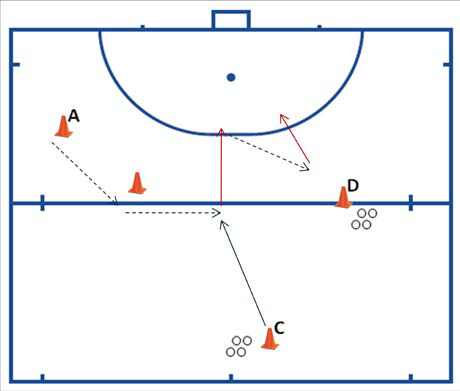

- The tagger should try to tap as many children as possible.
- If you are in danger of getting tapped you can call a television show and then the tagger is not allowed to tap you.
- You have to stand with your legs wide.
- The rest can be relieved by crawling between your legs.
- When you are tapped, you stand by the trainer.

- 1 or 2 taggers.
- On the spot where you are tapped, the tagger must hold his hand, for example, a hand on his shoulder.
- With the other hand another has to be tapped.

- defense intercepts the ball
- the ball is played to the right back
- the middle right pulls in so that the flank is open
- the back right plays the ball into the depths to the striker
- the striker pulls out to take the ball along the line
- Have 5 attackers practice with the penalty corners
- goalkeeper in goal
- vary with declarers
- different variants
- At the end of the session, discuss 3 variants that can be used in the competition








